About The Silmarillion
Historical Background
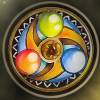 The Silmarillion contains the mythology to which the characters in
the Lord of the Rings look back. The Lord of
the Rings describes the events of Middle-Earth at the end of the Third Age, while the
Silmarillion tells the stories of the First Age and earlier. The Silmarillion was J.R.R. Tolkien's life work. He
began writing the first version of these stories in notebooks in 1917 during World War I.
He was still working on these stories -- revising, reworking, and expanding them -- when he
died in 1973.
The Silmarillion contains the mythology to which the characters in
the Lord of the Rings look back. The Lord of
the Rings describes the events of Middle-Earth at the end of the Third Age, while the
Silmarillion tells the stories of the First Age and earlier. The Silmarillion was J.R.R. Tolkien's life work. He
began writing the first version of these stories in notebooks in 1917 during World War I.
He was still working on these stories -- revising, reworking, and expanding them -- when he
died in 1973.
When Tolkien began, the collection of tales was to be called the Book of Lost Tales. The proposed work would contain around fifteen stories, and Tolkien completed quite a few of these. It included a frametale: a great mariner from England had sailed west to an island of the Elves, and the Elves told him this cycle of stories about their history. Later (most likely in 1951), Tolkien wrote a letter describing his youthful intentions at the time he began these stories in 1917:
Once upon a time ... I had a mind to make a body of more or less connected legend, ranging from the large and cosmogonic, to the level of romantic fairy-story ... which I could dedicate simply: to England; to my country. ... I would draw some of the great tales in fullness, and leave many only placed in the scheme, and sketched. The cycles should be linked to a majestic whole, and yet leave scope for other minds and hands, wielding paint and music and drama (The Letters of Tolkien, Letter 131).
 (At the time of this letter in 1951, he called his 1917-intentions “absurd” and asked
the reader not to laugh at his lofty youthful ambitions.) He never finished the Book
of Lost Tales, but he did not abandon the stories. He took five of the central stories and began
retelling them as epic poems. Only two made it past the opening lines: Turin and the Dragon (over
2000 lines) and Beren and Luthien (over 4000 lines). He also made maps and detailed timelines.
His mythological universe continued to expand whenever he would start writing. He added more
stories and more details. By 1937, he had a significant portion of a new collection of these stories
finished and sought to get it published. But the publisher was not as interested in the
Silmarillion tales as it was in a sequel to the Hobbit.
So Tolkien set aside this work and started writing the Lord of the Rings.
But the stories from the Silmarillion were too dear to his heart, and
the Lord of the Rings quickly became part of that same universe.
(At the time of this letter in 1951, he called his 1917-intentions “absurd” and asked
the reader not to laugh at his lofty youthful ambitions.) He never finished the Book
of Lost Tales, but he did not abandon the stories. He took five of the central stories and began
retelling them as epic poems. Only two made it past the opening lines: Turin and the Dragon (over
2000 lines) and Beren and Luthien (over 4000 lines). He also made maps and detailed timelines.
His mythological universe continued to expand whenever he would start writing. He added more
stories and more details. By 1937, he had a significant portion of a new collection of these stories
finished and sought to get it published. But the publisher was not as interested in the
Silmarillion tales as it was in a sequel to the Hobbit.
So Tolkien set aside this work and started writing the Lord of the Rings.
But the stories from the Silmarillion were too dear to his heart, and
the Lord of the Rings quickly became part of that same universe.
 Tolkien worked on the Lord of the Rings for fourteen years, until 1951.
When he finished, he had much rewriting of the Silmarillion to do. (For
example, he invented Galadriel when writing the Lord of the Rings; she
had to be written back into the Silmarillion.) He made major revisions
and expansions -- nearly tripling the size of what he had completed by 1937 -- until his death in
1973. His son Christopher Tolkien completed the Silmarillion based on
his father's earlier versions and notes, and he published it in 1977.
Tolkien worked on the Lord of the Rings for fourteen years, until 1951.
When he finished, he had much rewriting of the Silmarillion to do. (For
example, he invented Galadriel when writing the Lord of the Rings; she
had to be written back into the Silmarillion.) He made major revisions
and expansions -- nearly tripling the size of what he had completed by 1937 -- until his death in
1973. His son Christopher Tolkien completed the Silmarillion based on
his father's earlier versions and notes, and he published it in 1977.
Overview
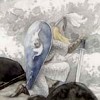 The Silmarillion begins with the creation of the world. Iluvatar, the
one God over all, created great spirits. One of these spirits, Melkor, fell into evil and became
the Dark Lord of the world. The world was created when Iluvatar gave existence to the songs of the
spirits. Some of the spirits entered into this new world; these spirits were called the Valar,
‘the Powers’; men have often called these spirits ‘Gods’. Melkor entered
the world with the Gods. The Gods fought many wars with Melkor; they then made and
fortified their dwellings in the West of the world (called Valinor) and Melkor built his fortress in
the North of the world (called Angband). Middle-Earth is located in the middle of the world; Valinor
is across the Great Sea to the west. Here's a list of the Gods mentioned in my project:
The Silmarillion begins with the creation of the world. Iluvatar, the
one God over all, created great spirits. One of these spirits, Melkor, fell into evil and became
the Dark Lord of the world. The world was created when Iluvatar gave existence to the songs of the
spirits. Some of the spirits entered into this new world; these spirits were called the Valar,
‘the Powers’; men have often called these spirits ‘Gods’. Melkor entered
the world with the Gods. The Gods fought many wars with Melkor; they then made and
fortified their dwellings in the West of the world (called Valinor) and Melkor built his fortress in
the North of the world (called Angband). Middle-Earth is located in the middle of the world; Valinor
is across the Great Sea to the west. Here's a list of the Gods mentioned in my project:

- Manwe: The God of the air and head of the Gods.
- Ulmo: The God of the sea.
- Yavanna: The Goddess of nature.
- Mandos: The God of the underworld. The spirits of the dead go to the ‘Halls of Mandos’.
- Melkor: The Dark Lord.
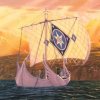 Elves and Men are called the “Children of Iluvatar”; they were not originally part of the
song of the spirits. To each race, Iluvatar gave different gifts and different destinies. Elves
were given long life, so long that Men called them immortal. They did not die from old age, but they
could be killed in battle or die from grief. When an Elf died his spirit departed to the halls of
Mandos, and he remained within the circles of the world; elves remained in the world as long as it
lasted. Men were given very short lives. They could die from old age or illness, and were very frail.
When a man died his spirit also departed to the halls of Mandos, but only for a brief time; the
spirit of the man would leave the circles of the world to a destiny that the Elves did not know.
Elves and Men are called the “Children of Iluvatar”; they were not originally part of the
song of the spirits. To each race, Iluvatar gave different gifts and different destinies. Elves
were given long life, so long that Men called them immortal. They did not die from old age, but they
could be killed in battle or die from grief. When an Elf died his spirit departed to the halls of
Mandos, and he remained within the circles of the world; elves remained in the world as long as it
lasted. Men were given very short lives. They could die from old age or illness, and were very frail.
When a man died his spirit also departed to the halls of Mandos, but only for a brief time; the
spirit of the man would leave the circles of the world to a destiny that the Elves did not know.
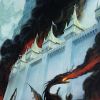 Elves awoke first in Middle-Earth. The Gods found the Elves and invited them to cross the sea to
Valinor. Some of the Elves journeyed west to the sea and were brought to Valinor by
Ulmo. In Valinor, Yavanna had made the Two Trees that provided light for the Gods. Feanor a prince
of one of the royal houses of Elves, took some of the light and crafted the most beautiful jewels
ever made: the Silmarils (Silmarillion means ‘Account of the Silmarils’). Melkor
came to Valinor to kill the Two Trees and steal the Silmarils because he lusted after them. He took
them back to Angband and set them in his Iron Crown. Feanor rallied most of the Noldor to return to
Middle-Earth to regain the Silmarils; he and his sons swore a terrible oath that they would not rest
while any other held the Silmarils.
Elves awoke first in Middle-Earth. The Gods found the Elves and invited them to cross the sea to
Valinor. Some of the Elves journeyed west to the sea and were brought to Valinor by
Ulmo. In Valinor, Yavanna had made the Two Trees that provided light for the Gods. Feanor a prince
of one of the royal houses of Elves, took some of the light and crafted the most beautiful jewels
ever made: the Silmarils (Silmarillion means ‘Account of the Silmarils’). Melkor
came to Valinor to kill the Two Trees and steal the Silmarils because he lusted after them. He took
them back to Angband and set them in his Iron Crown. Feanor rallied most of the Noldor to return to
Middle-Earth to regain the Silmarils; he and his sons swore a terrible oath that they would not rest
while any other held the Silmarils.
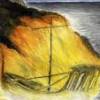 The Elves fought a great war, the War of Jewels, with Melkor to recover the Silmarils. The war
lasted for five hundred years. Melkor had many victorious battles, and the Elves suffered great
loss. The oath that Feanor and his sons swore caused them commit terrible deeds -- even against
their own kin -- and there was always strife between the Elves from Valinor. There was also strife
between them and the Elves who had remained in Middle-Earth. During this time, men awoke in Middle-Earth,
and few of their houses ventured west to come into contact with the Elves; there was strife
between all the Elves and these Men. When the last great Elvish stronghold (Gondolin) was overrun
and it looked like all hope was lost, the great mariner Earendil Halfelven (son of the man Tuor and
the elf Idril) sailed across the Great Sea to Valinor and pleaded with the Gods to have mercy on
Elves and Men and deliver them from Melkor. The Gods sent an army to Middle-Earth to destroy Melkor's
stronghold and regain the Silmarils, thus ending the War of Jewels.
The Elves fought a great war, the War of Jewels, with Melkor to recover the Silmarils. The war
lasted for five hundred years. Melkor had many victorious battles, and the Elves suffered great
loss. The oath that Feanor and his sons swore caused them commit terrible deeds -- even against
their own kin -- and there was always strife between the Elves from Valinor. There was also strife
between them and the Elves who had remained in Middle-Earth. During this time, men awoke in Middle-Earth,
and few of their houses ventured west to come into contact with the Elves; there was strife
between all the Elves and these Men. When the last great Elvish stronghold (Gondolin) was overrun
and it looked like all hope was lost, the great mariner Earendil Halfelven (son of the man Tuor and
the elf Idril) sailed across the Great Sea to Valinor and pleaded with the Gods to have mercy on
Elves and Men and deliver them from Melkor. The Gods sent an army to Middle-Earth to destroy Melkor's
stronghold and regain the Silmarils, thus ending the War of Jewels.